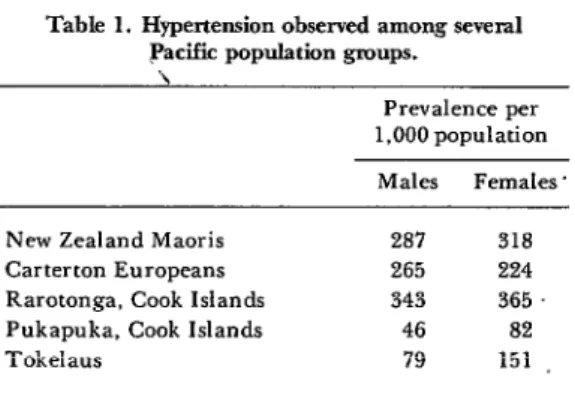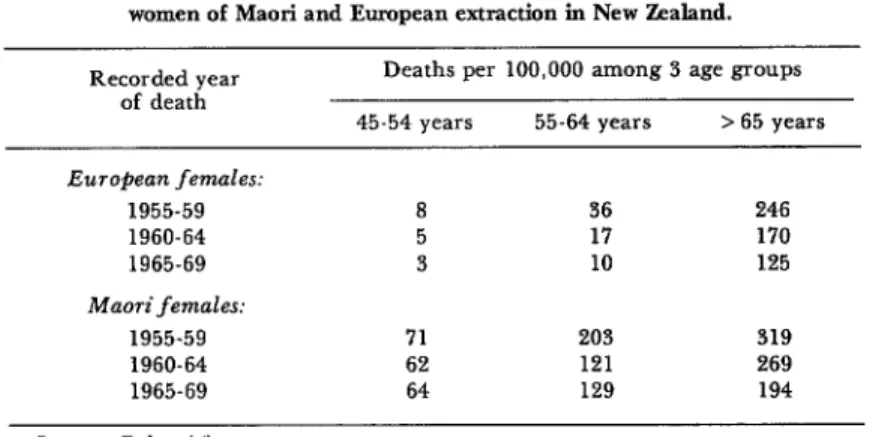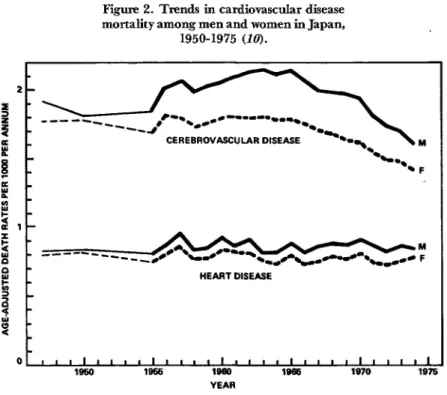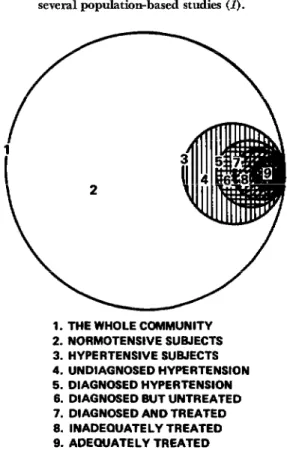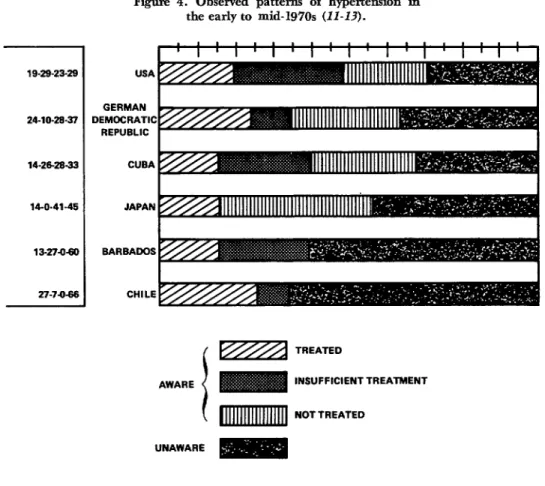Bell I’,,,I A,,, Hwlrh Or~mr 13(4). 1979.
INTERNATIONAL PROGRAMS IN BLOOD PRESSURE CONTROL1
Jorge Litvak,* H&tor Boffi,* Zbynek Piss, 3 and Tom Strasser’
The scope of the world hypertension problem places a premium on the need to devise preventive measures and to make better use of what we now know about controlling hypertension. This article reviews a number of research findings in the field and describes current work of the World Health Organization directed at achieving more effective hypertension control.
Introduction
In contrast to many diseases causing car- diovascular difficulties-such as ischemic heart disease, rheumatic fever, and Chagas’ disease-hypertension is an almost univer- sal problem, one common in tropical, sub- tropical, and temperate areas as well as in both developed and developing countries.
This article does not seek to provide an exhaustive review of the literature on the epidemiology of hypertension. Nevertheless, it is worth noting that hypertension afflicts an estimated 10 to 15 per cent of all adults in the developed countries of Europe and North America. Data on the prevalence of hypertension in developing countries- reported in a number of publications and through the WHO Collaborative Program on Hypertension Control -invariably show similar figures (I). In comparing such data, however, care must be taken to consider pos- sible differences in the definition of hyper- tension employed, the variability of blood pressure reading, and a lack of the common
‘Paper presented at the National Conference on High Blood Pressure Control held at Los Angeles, California, on 2-4 April 1978. Also appearing in Spanish in the Boletin de la Ofmna Sanitaria Pan- americana.
ZNon-Communicable Diseases Unit, Division of Disease Control, Pan American Health Organization.
kardiovascular Diseases Unit, Division of Non- Communicable Diseases, World Health Organization, Geneva, Switzerland.
denominators that help to ensure statistical comparability.
The very complex problem of hyperten- sion involves two crucial needs. One need is for research into the origins and causes of hypertension-in order to seek ways to pre- vent this condition. The other is for more experience on how to apply available knowledge-in order to control the disease with the therapeutic and health care arsenal available today.
Research
Contradictory research data now exist on the relative importance of genetic and environmental factors, and there are a number of peculiar and intriguing points about blood pressure that warrant further investigation. For example, “pockets” of people whose blood pressure does not in- crease with age have been identified in sev- eral parts of the world. If such groups of people rarely have hypertension, coronary attacks, and strokes, this may mean that these are not inevitable conditions-and that it is possible to investigate factors res- ponsible for their prevention.
Polynesians in the Pacific region have an old radition of migration that continues today. The first wave of Polynesians, the New Zealand Maori, came to New Zealand from the Central Pacific some time in the fourteenth century. In 1946 there were about 2,000 such islanders in New Zealand;
Litvak et al. l BLOOD PRESSURE CONTROL PROGRAMS 3.55
in 1977 there were 60,000. People from Samoa, the Cook Islands, Niue, Tokelau, and Tonga (see Table 1) now make up an important, though still relatively small segment of New Zealand society (Z-4).
The Tokelau Island Migrant Study, ini- tiated in 1966, has afforded an excellent opportunity to study Tokelauans moving from their native environment, which poses a low risk of high blood pressure, into high- ly urbanized life in New Zealand. This study may well represent a nearly unique “experiment of nature” (2).
The study has shown blood pressure to be higher among Tokelauans in New Zealand than among those remaining in Tokelau. The fact that these differences were ob- served in both children and adults strongly suggests that environmental factors were playing an important role.
Physical factors-such as caloric intake, salt consumption, physical activity, and physique-may be basic determinants of hypertension. But psychosocial factors may also account for much of the phenomenon; for example, migration often exposes settlers to situations and relationships that they are not prepared for, and this may initiate changes in the body’s control of blood pres- sure that could cause the pressure to in- crease. In reality, both sets of factors (physical and psychosocial) probably con- tribute to hypertension.
Cook Island studies carried out in 1964
Table 1. Hypertension observed among several pacific population groups.
\
Prevalence per 1,000 population Males Females.
New Zealand Maoris 287 318
Carterton Europeans 265 224
Rarotonga, Cook Islands 343 365
Pukapuka, Cook Islands 46 82
Tokelaus 79 151 .
Sources: Prior et al. (2) and Prior (4).
revealed very different patterns of blood pressure among two groups of islanders, the Pukapuka and the Rarotonga. But blood pressure was not the only important dif- ference-weight differed as well. There was also a considerable difference in the two population’s diets and salt intakes; the Pukapukans ordinarily used little salt, while the Rarotongans, who were moving toward a more modern form of diet, had a much higher salt intake (3).
Sociocultural differences between the two groups were also considerable. Rarotongans who lived in Avarua, the main town in the group of islands, were being exposed to the ideas, customs, foods, and goals of an in- dustrial society-things that contrasted sharply with the subsistence-oriented life- styles of the Pukapukans.
Mortality data have shown Maori men and women in New Zealand to have even higher rates of hypertensive heart disease than Europeans. A still more striking find- ing (see Table 2) was that Maori women suffer four times higher mortality from coronary heart disease than their European counterparts (4).
The World Health Organization (WHO) through its expert and advisory committees and collaborating centers, is playing an active role in testing all this information with the aim of developing a potential tool for early prevention of cardiovascular disease.
Most epidemiologic studies from different countries support the observation that both moderate and severe elevations of blood pressure increase the risk of morbidity and mortality from coronary, cerebrovascular, and kidney disease (5). These studies also show that modern antihypertensive drug therapy can effectively reduce high blood pressure and, consequently, the excess risk. The most significant investigation in this field is the well known Veterans Adminis- tration- Cooperative Study (6, 7).
356 PAHO BULLETIN l vol. 13, no. 4, 1979
Table 2. Mortality fmm hypertensive heart disease observed among women of Maori and European extraction in New Zealand.
Recorded year of death
Deaths per 100,000 among 3 age groups
45-54 years 55-64 years > 65 years
European females: 1955-59 1960-64 1965-69 Maori females:
1955.59 1960.64 1965-69
8 36 246
5 17 170
3 10 125
71 203 319
62 121 269
64 129 194
Source: Prior (4).
“At what levels of blood pressure elevation should pharmacological treatment of hyper- tension be initiated?” The question can be answered only by extensive therapeutic trials on great numbers of subjects. Nine such trials-financed by national agencies for medical research in Australia, France, Great Britain, and the United States-are now underway in various parts of the world. In an effort to coordinate these re- search activities, WHO and the Interna- tional Society of Hypertension (ISH) are providing liaison for the ongoing trials. (The activities of the Mild Hypertension Liaison Committee have already been reported in two WHO/ISH documents- 8, 9.)
According to available national statistics (see Figures 1 and Z), mortality from cere- brovascular disease has been on the wan& in many countries (10). One reason for this may be that potent modern treatment has been given effectively to large numbers of several hypertensive patients running a high risk of stroke., HoweSer , the decline in mortality started long before new antihy- pertensive drugs were introduced, raising the possibility that this downward trend may in fact result from a complex of inter- vening factors.
Epidemiologic analysis of the situation in various countries in the early 1970s showed that then-available knowledge was being
applied to only a small fraction of the tre- mendous number of hypertensives around the world. Indeed, as Figure 3 shows, it be- came evident that only about half of the hypertensive subjects in the general popula-
Figure 1. Mortality from cerebmvascular disease in the 55-64 age group of five countries,
1955-1970 (10).
Litvak et al. 9 BLOOD PRESSURE CONTROL PROGRAMS 357
Figure 2. Trends in cardiovascular disease mortality among men and women in Japan,
1950-1975 (IO).
tion of most developed countries were aware of their high blood pressure, only about half of those aware of the problem were being treated, and only about half of those treated were considered adequately treated (I). This situation existed despite the fact that the risks of high blood pressure were recognized, and despite the fact that the benefits of consistently and markedly lower- ing elevated blood pressure were well- known to health professionals. As Figure 4 shows, more recent data have refined this rough quantification by “halves” without detracting from the validity of the under- lying concept (11-13).
Hypertension, considered from the point of view of health care epidemiology, has until now involved a double paradox. That is, although high blood pressure can be measured easily, hypertension has often re- mained undiagnosed; and although rela- tively simple and efficient treatment has been available, the patients all too often have remained untreated. Since the number of hypertensive subjects worldwide is enor-
mous, these hypertension paradoxes clearly pose one of the priority health care prob- lems on the international scene.
WHO Control-Related Activities
358
Figure 3. Typical patterns of hypertension and hypertension treatment for a developed country in the early 1970s. The areas of the circles shown correspond to the actual proportions observed in
several population-based studies (I).
1. THE WHOLE COMMUNITY
2. NORMOTENSIVE SUBJECTS
3. HYPERTENSIVE SUBJECTS
4. UNDIAGNOSED HYPERTENSION
5. DIAGNOSED HYPERTENSION 6. DIAGNOSED BUT UNTREATED 7. DIAGNOSED AND TREATED 6. INADEQUATELY TREATED
9. ADEQUATELY TREATED
were indicated. Two years later, in 1963, WHO gave the methods for assessing hyper - tension in a given population a more de- tailed review (16), particularly from the standpoint of international comparability.
During a 1970 WH 0 seminar that was re- viewing the impact stroke has on the health of populations (17), it became apparent that many cases of stroke could be prevented if greater vigor and attention were devoted to treating hypertension. This conclusion, together with a strong recommendation to initiate “model programs in the context of their local health services to produce prac- tical methods for both case-finding and delivery of adequate continued treatment,” gave rise to a more specific and program-
PAHO BULLETIN l vol. 13, rzo. 4, 1979
oriented WHO commitment to study and promote the control of hypertension in entire populations.
The framework and objectives of a WHO project along these lines were set forth at a meeting held in Geneva in 1971 (18). That same year investigators from 15 centers in various countries around the world met in Gijteborg, Sweden (19), and adopted the protocol for a cooperative project. A com- munity approach to hypertension control was chosen, and in 1972 a number of cen- ters initiated pilot community hypertension control programs to study the feasibility and effectiveness of the design. By the end of the same year, the first preliminary informa- tion generated by the study was reviewed (20). In 1976 the Pan American Health Organization (the WHO Regional Office for the Americas) and eight countries of the Region initiated an inter-country hyperten- sion control program based on these WHO guidelines (13).
The WHO Hypertension Control Project
WHO is currently conducting this coop- erative pilot project through a network of centers covering practically all parts of the world. As Figure 5 indicates, these centers are operating in Argentina, Barbados, Bolivia, Brazil, Chile, Cuba, Ecuador, Peru, and Venezuela in the Americas; in Ghana, Nigeria, and Senegal in Africa; in Czechoslovakia, Finland, France, the Ger- man Democratic Republic, Italy, Portugal, Sweden, Yugoslavia, and the U.S.S.R. on the European continent; and in China, Israel, Japan, and Mongolia in Asia.
Litvak et al. l BLOOD PRESSURE CONTROL PROGRAMS 359
Figure 4. Observed patterns of hypertension in the early to mid-1970s (11-13).
19-29-23-29 USA GERMAN 24-10-28-37 DEMOCRATIC
REPUBLIC 14.282833 CUBA
w-0.41-45 JAPAN
12-27-0-60 BARBADOS
27-70-66 CHILE
1
FA TREATED
AWARE INSUFFICIENT TREATMENT NOT TREATED
UNAWARE
360 PAHO BULLETIN l vol. 13, 120. 4, 1979
In view of the aims of the study, the con- trol programs need to be organized so as to respect and take advantage of the existing systems of medical care delivery. Each pro- gram should be seen as intensifying, im- proving, and extending current activities in this field.
The general operational plan for the study of community hypertension control is shown in Figure 6 (5). The first step is establishment of a program center, an or- ganizational element needed to implement a community control program. The pro- gram center begins its work by selecting the community to be studied, a choice that should be based on both practical and theo- retical considerations. After designation of the study community, and also a reference community, samples are drawn up and a baseline survey is made to assess the epide- miologic situation in both communities.
Those people in the study community found to have blood pressures in the hyper- tensive range are registered.
Next, a search for previously undetected cases of hypertension is attempted. If ap- propriate, cooperative liaison is established with the physicians and medical institu- tions in the area; and, if necessary, facili- ties for better medical care are created. The physicians in the program community are contacted and provided with up-to-date guidelines for therapy. When indicated, special training in hypertension is offered to the physicians in the study community, and information on hypertension is pro- vided to the general population. Registered hypertensive subjects are followed up, and once a year findings are again recorded.
While all this is being done in the study community, the reference community con- tinues to receive the usual medical care
Figure 6. The general plan of operation for the WHO study of community hypertension control.
PROGRAM CENTER
STUDY COMMUNITY REFERENCE COMMUNITY
BASELINE SITUATION BASELINE SITUATION
HEALTH EDUCATION COOPERATIVE NErWORK INTEGRATED SERVICES
REGISTRATION
I +
SCREENINGCASE FINDING ANNUAL FOLLDWUP
3
ANNUAL FOLLOW-UP I
Litvak et al. l BLOOD PRESSURE CONTROL PROGRAMS 361
(i.e., care without registration of hyperten- sives, case-finding efforts, special health care programs, or special educational pro- grams). At the end of the study period (five years) a final survey is made in both the study and reference communities and a final analysis is performed.
Data from these final surveys in both communities are compared to the baseline data for those communities. Changes in both communities should be expected (see Figure 7). Therefore, evaluation of the control program’s effect needs to be based on the difference observed between the “spontaneous” change occurring in the reference community and the “spontaneous plus program-induced” change occurring in the study community.
The project involves centers providing three different kinds of cooperation: the full cooperation provided by centers that are following the WHO protocol by con- ducting initial and follow-up surveys of a reference , community; the cooperation pro-
vided by centers that have encountered dif- ficulties in establishing a reference com- munity and that are testing only the feasi- bility of the community control program; and the cooperation provided by other centers that are contributing to the project by exchanging information about methods of controlling hypertension in the com- munity.
In this world project, the case registry is regarded as an operative control instru- ment. The purpose of making such a regis- try is to define the initial situation before intervention begins and to provide a basis for monitoring case follow-up activities. At present almost 30,000 hypertensive subjects are included in the project.
Preliminary Results
Of the participating centers, five have now completed their five-year study pro- grams and have begun their evaluations. The other will reach the end of their study
Figure 7. This chart shows the basic principle to be applied in evaluating the effects of program
intervention on hypertension.
HYPERTENSION SITUATION IN THE COMMUNITY
BASELINE SITUATION
0 1 2 3 4 5
YEARS
a = “IMPROVEMENT” IN STUDY COMMUNITY b = POSSISLE SPONTANEOUS “IMPROVEMENT” IN
REFERENCE COMMUNITY
362 PAHO BULLETIN l vol. 13, no. 4, 1979
programs in anywhere from one to four years.
Although some interim analysis of data is available, we are not yet in a position to define anything more than some of the pat- terns that seem to be emerging. Both data analysis and program evaluation conducted to date have pointed to some methodological weaknesses that merit discussion in the light of the aims of the study. Case registra- tion, for example, is providing data on cer- tain items that are less amenable to cross- center analysis than others. Care must be taken here, because data without adequate standardization and quality control, when compared for all centers, might give mis- leading results.
It must also be kept in mind that the re- gistry information obtained does not neces- sarily reflect all that is happening in the study population; i.e., the program may have an influence on unregistered hyper- tensives. In addition, changes observed in the population may not be due solely to the program, since an increasing frequency of antihypertensive treatment has been found to occur in many places independently of special control programs. Furthermore, the well known phenomenon of “regression toward the mean” tends to produce a de- cline in the blood pressure of any group selected for casually elevated blood pressure values.
The WHO protocol specifies that an an- nual follow-up form should be filled out for each registered hypertensive subject. While the ratio of total forms received to total forms expected (up to the fourth annual follow-up) has been satisfactory in some centers, in others the ratio has been shrinking rapidly. Although this phenome- non still requires considerable further ana- lysis, one fact is worth pointing out now. That is, the programs showing the lowest rates of attrition seem to be those that are most closely integrated with existing health services, that involve the active participa- tion of local health centers, that utilize
auxiliary personnel, and that include an element of health education and communi- ty participation.
This is the case, for example, in the county of North Karelia, Finland, where the population of hypertensives under con- trol has increased from 1.9 to 9.7 per cent of the total population in five years and where the rate of attrition has been extremely low. At the other end of the spectrum, the least effective results seem to be coming from centers where the programs are both vertical and lacking in communi- ty-based logistical support.
An interim analysis of registration data, keeping in mind the forementioned pos- sibility of considerable bias, seems to indi- cate some general trends. There is a moder- ate decline in the average blood pressure of treated groups-a decline that might be considered insufficient when treating an individual patient, but not so insufficient when working with a collective population. On the other hand, this decline in the treated group’s blood pressure cannot be fully ascribed to treatment. Obviously, the decline does not have the value of random drug trial results, because treatment was not given at random. This, however, was not the aim of the study. Another trend is that all centers have shown the percentage of treated persons to be increasing with each follow-up; this probably reflects a bias due to missing information about persons who are not treated.
Concluding Remarks
Litvak et al. . BLOOD PRESSURE CONTROL PROGRAMS 363
It seems clear, however, that this system- As Dr. H&ctor Acuiia, Director of the Pan atic approach must be community-oriented, American Health Organization, said in his and that a certain organizational threshold message for World Health Day 1978: “In of health services must be reached before a many countries of the Americas, chronic community hypertension control program diseases are now contesting the place tradi- can succeed. We also believe that it is time to tionally held by communicable diseases as recognize that hypertension clinics acting as themajor cause of death and disability. . . .
the centralized agents of vertical programs Nationwide control programs based on
are inadequate-because they ignore the population studies should be carried out at need for a comprehensive approach to the community level through the existing medical care of the patient. Finally, and structure of the medical services.” This, in most important, we believe a key prerequi- essence, is why the World Health Organiza- site for successful implementation of a com- tion, the Pan American Health Organiza- munity hypertension control program is tion, and a significant share of their Mem- that full consideration be given to the exist- ber Governments have joined together in ing system of health services in each coun- the present pilot effort to combat hyper-
try or area involved. tension.
The complex problem of hypertension affects virtually all developed and developing areas. Its importance has created an urgent need to find ways the disease might be prevented and ways to better apply what we now know about hyperten- sion control.
Recent research has turned up a number of interesting findings-including the fact that cer- tain “pockets” of people do not tend to experi- ence increasing blood pressure with age. The World Health Organization (WHO) is now play- ing an active role in testing all available infor- mation with the aim of developing a potential tool for early prevention of cardiovascular disease.
Regarding hypertension control, WHO is
currently sponsoring a large number of coor- dinated pilot programs in member countries. These programs are designed to investigate whether application of available control mea- sures in specified communities will reduce the impact of hypertension in those communities. At present almost 30,000 hypertensive subjects are participating in these programs. It is still too early to say how greatly these programs will in- fluence levels of hypertension in the communi- ties involved; but it is clear that they have al- ready contributed to growing world awareness of the need for a systematic approach to hyperten- sion control.
REFERFaNCl?.S
(I) Strasser, T. Pilot programmes for the con- trol of hypertension. WHO Chron 26:451, 1972. (2) Prior, I.A.M., J . M. Stanhope, J. G. Evans, and E. Salmond Clare. The Tokelau Island migrant study. Int J Epidemiol 3:225, 1974.
(3) WHO Regional Office for the Western Pacific. Second Regional Seminar on the Pre- vention and Control of Cardiovascular Diseases:
Final Report. Document ICP/CVD/OOl. Ma-
nila, The Philippines, 1975.
(4) Prior, I.A.M. Cardiovascular epidemio-
logy in New Zealand and the Pacific. N Z Med J 80:245, 1974.
(5) World Health Organization. Community Control of Hypertension. WHO Internal Docu- ment CVD/74.3 (II). Geneva, 1974.
(6) Veterans Administration Cooperative Study Group on Antihypertensive Agents. Ef- fects of treatment on morbidity in hypertension. Results in patients with diastolic blood pressure
averaging 115 through 129 mm Hg. JAMA
202:1028, 1967.
364 PAHO BULLETIN l vol. 13, no. 4, 1979
Study Group on Antihypertensive Agents. Ef- fects of treatment on morbidity in hypertension: II. Results in patients with diastolic blood pres- sures averaging 90 through 114 mm Hg. JAMA
213:1143, 1970.
(8) World Health Organization and the In- ternational Society of Hypertension. Effecti- veness of Treatment in Mild Forms of Hyperten- sion. Joint WHO/ISH Meeting held at Madrid, Spain, in March 1975. Document CVD/75.5. Geneva, 1975.
(9) World Health Organization and the In- ternational Society of Hypertension. Joint
WHO/ISH Mild Hypertension Trial Liaison
Committee. WHO Document CVD/76.4. Sydney, Australia, 1976.
(IO) Hatano, S. The Worldwide Problem of Hypertension and Stroke. In: Hypertension and Stroke Control in the Community. World Health Organization, Geneva, 1976, p. 19.
(II) National Heart Institute of the United States. Survey of Fourteen Communities, 1973.
1974. In: Hypertension Detection and Follow-up Study, Director’sReport. Bethesda, Md., U.S.A., 1977, p. 131.
(12) World Health Organization. WHO an- nual meetings on community control of hyper- tension, 1972-1977 (Internal Documents WHO/ CVD).
Group on Hypertension Control. Washington, D.C., 1977.
(14) World Health Organization. Hyperten- sion and Coronary Heart Disease: Classification and Criteria for Epidemiological Studies. WHO Technical Report Series, No. 168. Geneva, 1959.
(15) World Health Organization. Arterial Hypertension and Ischaemic Heart Disease: Pre- ventive Aspects. WHO Technical Report Series, No. 231. Geneva, 1962.
(16) World Health Organization. Arterial Hypertension and Ischaemic Heart Disease. Geneva, 1963.
(17) World Health Organization. Cerebro- vascular Diseases: Prevention, Treatment and Rehabilitation: Report of a WHO Meeting (Monaco, 1970). WHO Technical Report Series, No. 469. Geneva, 1971.
(18) WorldHealth Organization. WHO Meet- ing on the Control of Stroke and Hypertension in the Community. WHO Document CVD/71.3. Geneva, 1971.
(19) World Health Organization. WHO Meet- ingon Community Control of Stroke and Hyper-
tension. WHO Documents CVD/72.la and
CVD/72.lb. G’dteborg, Sweden, 1971.
(20) WorldHealth Organization. WHO Meet- ingon Community Control of Stroke and Hyper-
tension. WHO Documents CVD/73.2 (I) and
(13) Pan American Health Organization. CVD/73.2 (II). Geneva, 1973.
Final Report: Second Meeting of the Working
NUTRITION*
“Nutrition Made Simple by the Caribbean Food and Nutrition Insti- tute” has been a recent series in Nyam News, newsletter of that organiza- tion. Vitamins-fat-soluble vitamins A, D, E, and K and water-soluble vitamins BI, B2, C, and niacin-and minerals are discussed in the February and March issues. subsequent issues answer questions such as, Does diet affect the brain? Does breastfeeding keep a woman from be- coming pregnant? What is the nutritional contribution of green paw-paw?
*Nyam News. January-March, 1979.
